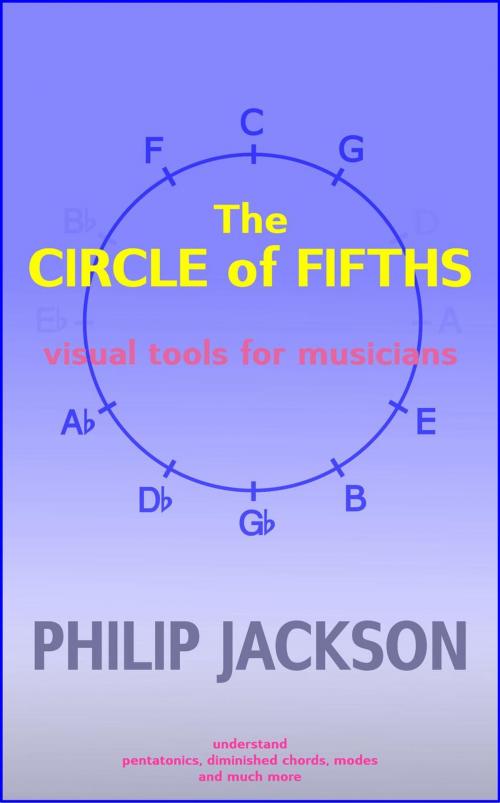The Circle of Fifths
Nonfiction, Entertainment, Music, Music Styles, Jazz & Blues, Jazz, Theory & Criticism, Theory| Author: | Philip Jackson | ISBN: | 9781524252205 |
| Publisher: | Philip Jackson | Publication: | March 14, 2016 |
| Imprint: | Language: | English |
| Author: | Philip Jackson |
| ISBN: | 9781524252205 |
| Publisher: | Philip Jackson |
| Publication: | March 14, 2016 |
| Imprint: | |
| Language: | English |
“The Circle of Fifths - visual tools for musicians” presents a new way for all players to learn their music theory in a fresh manner that has previously been neglected by so many teachers. It will be of value to practical musicians at all levels and particularly useful to improvisers and jazz players at the beginning and early stages of improvisation. Think of all those occasions when you tried to recall some aspect of musical theory on the fly to use it without interrupting your flow. You will find it so much easier when using these proven techniques.
Philip Jackson is a composer and arranger as well as a clarinet player. He brings his engineering background into use as he re-examines the traditional approach to some of the concepts used in music theory. Why have so many teachers neglected the visual aspect of memory? It is too obvious just to say that music involves hearing, indeed active listening, because so many beginners have real problems to hear exactly which chord is being played. Philip believes that good teaching practice must involve as much variety as is useful and that includes not neglecting the visual part of memory.
The amazingly versatile circle of fifths is presented in this book in ways which will help you learn your music theory, to discover and recall a cadence, turnaround or other chord progression, (ii – V -I, iii – vi – ii – V – I or just IV – V - I) you need or that elusive diminished seventh chord. It is not limited to guitar players or pianists. Any and all practising musicians – players of any instrument, improvising soloists as well as composers, and arrangers - will find real benefit from using their visual memory.
This book, “The Circle of Fifths – visual tools for musicians”, will teach you to draw the circle and with little effort you will soon learn to visualize its layout. Once this is mastered, you will learn to appreciate all its possibilities covering the entire range of music theory and this will help you to guarantee good results in, for example, chosing substitute dominants. You will 'see' the whole tone scales. And the relationship between quartal harmony and the pentatonic modes will be revealed to you. You will be able to visualize and select the best inside pentatonic scales appropriate to your scale or mode.
When you are playing in a group with your friends, you will be able to visualize rapidly what keys they need to play in to take into account the different instruments in concert pitch like the guitar or trombone; in Bb like the trumpet, tenor sax and clarinet; in Eb like the alto saxophone. And if your singer needs you all to go down a tone, the circle will help you quickly decide on the new keys.
More than sixty new and original drawings have been especially created for “The Circle of Fifths – visual tools for musicians” to provide powerful new insights which will make it easier for you to understand the logic behind the order of sharps and flats; the relationship between relative major and minor scales; to pick any interval you need and to be certain to achieve the results you seek. You will no longer be left wondering from which scale a chord comes or which scale to use when you want to improvise over any given chord. Find the relative minor? Avoid the tritone? No problem!
“The Circle of Fifths - visual tools for musicians” presents a new way for all players to learn their music theory in a fresh manner that has previously been neglected by so many teachers. It will be of value to practical musicians at all levels and particularly useful to improvisers and jazz players at the beginning and early stages of improvisation. Think of all those occasions when you tried to recall some aspect of musical theory on the fly to use it without interrupting your flow. You will find it so much easier when using these proven techniques.
Philip Jackson is a composer and arranger as well as a clarinet player. He brings his engineering background into use as he re-examines the traditional approach to some of the concepts used in music theory. Why have so many teachers neglected the visual aspect of memory? It is too obvious just to say that music involves hearing, indeed active listening, because so many beginners have real problems to hear exactly which chord is being played. Philip believes that good teaching practice must involve as much variety as is useful and that includes not neglecting the visual part of memory.
The amazingly versatile circle of fifths is presented in this book in ways which will help you learn your music theory, to discover and recall a cadence, turnaround or other chord progression, (ii – V -I, iii – vi – ii – V – I or just IV – V - I) you need or that elusive diminished seventh chord. It is not limited to guitar players or pianists. Any and all practising musicians – players of any instrument, improvising soloists as well as composers, and arrangers - will find real benefit from using their visual memory.
This book, “The Circle of Fifths – visual tools for musicians”, will teach you to draw the circle and with little effort you will soon learn to visualize its layout. Once this is mastered, you will learn to appreciate all its possibilities covering the entire range of music theory and this will help you to guarantee good results in, for example, chosing substitute dominants. You will 'see' the whole tone scales. And the relationship between quartal harmony and the pentatonic modes will be revealed to you. You will be able to visualize and select the best inside pentatonic scales appropriate to your scale or mode.
When you are playing in a group with your friends, you will be able to visualize rapidly what keys they need to play in to take into account the different instruments in concert pitch like the guitar or trombone; in Bb like the trumpet, tenor sax and clarinet; in Eb like the alto saxophone. And if your singer needs you all to go down a tone, the circle will help you quickly decide on the new keys.
More than sixty new and original drawings have been especially created for “The Circle of Fifths – visual tools for musicians” to provide powerful new insights which will make it easier for you to understand the logic behind the order of sharps and flats; the relationship between relative major and minor scales; to pick any interval you need and to be certain to achieve the results you seek. You will no longer be left wondering from which scale a chord comes or which scale to use when you want to improvise over any given chord. Find the relative minor? Avoid the tritone? No problem!















